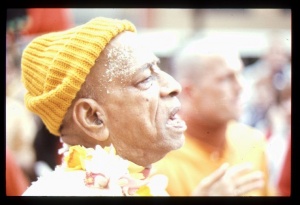CC Adi 7.15 (1975): Difference between revisions
(Vanibot #0027: CCMirror - Mirror CC's 1996 edition to form a basis for 1975) |
(Vanibot #0020: VersionCompareLinker - added a link to the Version Compare feature) |
||
| Line 2: | Line 2: | ||
<div style="float:left">'''[[Sri Caitanya-caritamrta (1975)|Śrī Caitanya-caritāmṛta (1975)]] - [[CC Adi (1975)|Ādi-līlā]] - [[CC Adi 7 (1975)|Chapter 7: Lord Caitanya in Five Features]]'''</div> | <div style="float:left">'''[[Sri Caitanya-caritamrta (1975)|Śrī Caitanya-caritāmṛta (1975)]] - [[CC Adi (1975)|Ādi-līlā]] - [[CC Adi 7 (1975)|Chapter 7: Lord Caitanya in Five Features]]'''</div> | ||
<div style="float:right">[[File:Go-previous.png|link=CC Adi 7.14 (1975)|Ādi-līlā 7.14]] '''[[CC Adi 7.14 (1975)|Ādi-līlā 7.14]] - [[CC Adi 7.16 (1975)|Ādi-līlā 7.16]]''' [[File:Go-next.png|link=CC Adi 7.16 (1975)|Ādi-līlā 7.16]]</div> | <div style="float:right">[[File:Go-previous.png|link=CC Adi 7.14 (1975)|Ādi-līlā 7.14]] '''[[CC Adi 7.14 (1975)|Ādi-līlā 7.14]] - [[CC Adi 7.16 (1975)|Ādi-līlā 7.16]]''' [[File:Go-next.png|link=CC Adi 7.16 (1975)|Ādi-līlā 7.16]]</div> | ||
{{CompareVersions|CC|Adi 7.15|CC 1975|CC 1996}} | |||
{{RandomImage}} | {{RandomImage}} | ||
==== TEXT 15 ==== | ==== TEXT 15 ==== | ||
<div class="verse"> | <div class="verse"> | ||
:ei tina tattva, | :ei tina tattva,--'sarvārādhya' kari māni | ||
:caturtha ye bhakta-tattva, | :caturtha ye bhakta-tattva,--'ārādhaka' jāni | ||
</div> | </div> | ||
| Line 32: | Line 31: | ||
<div class="purport"> | <div class="purport"> | ||
In his Anubhāṣya, Śrī Bhaktisiddhānta Sarasvatī Ṭhākura, describing the truth about the Pañca-tattva, explains that we | In his Anubhāṣya, Śrī Bhaktisiddhānta Sarasvatī Ṭhākura, describing the truth about the Pañca-tattva, explains that we can understand that Lord Śrī Caitanya Mahāprabhu is the supreme predominator and that Nityānanda Prabhu and Advaita Prabhu are His subordinates but are also predominators. Lord Śrī Caitanya Mahāprabhu is the Supreme Lord, and Nityānanda Prabhu and Advaita Prabhu are manifestations of the Supreme Lord. All of Them are viṣṇu-tattva, the Supreme, and are therefore worshipable by the living entities. Although the other two tattvas within the category of Pañca-tattva-namely, śakti-tattva and jīva-tattva, represented by Gadādhara and Śrīvāsa-are worshipers of the Supreme Lord, they are in the same category because they eternally engage in the transcendental loving service of the Lord. | ||
</div> | </div> | ||
Latest revision as of 19:21, 26 January 2020

A.C. Bhaktivedanta Swami Prabhupada
TEXT 15
- ei tina tattva,--'sarvārādhya' kari māni
- caturtha ye bhakta-tattva,--'ārādhaka' jāni
SYNONYMS
ei tina tattva—all three of these truths; sarva-ārādhya—worshipable by all living entities; kari māni—accepting such; caturtha—fourth; ye—who is; bhakta-tattva—in the category of devotees; ārādhaka—worshiper; jāni—I understand.
TRANSLATION
The three predominators [Caitanya Mahāprabhu, Nityānanda Prabhu and Advaita Prabhu] are worshipable by all living entities, and the fourth principle [Śrī Gadādhara Prabhu] is to be understood as Their worshiper.
PURPORT
In his Anubhāṣya, Śrī Bhaktisiddhānta Sarasvatī Ṭhākura, describing the truth about the Pañca-tattva, explains that we can understand that Lord Śrī Caitanya Mahāprabhu is the supreme predominator and that Nityānanda Prabhu and Advaita Prabhu are His subordinates but are also predominators. Lord Śrī Caitanya Mahāprabhu is the Supreme Lord, and Nityānanda Prabhu and Advaita Prabhu are manifestations of the Supreme Lord. All of Them are viṣṇu-tattva, the Supreme, and are therefore worshipable by the living entities. Although the other two tattvas within the category of Pañca-tattva-namely, śakti-tattva and jīva-tattva, represented by Gadādhara and Śrīvāsa-are worshipers of the Supreme Lord, they are in the same category because they eternally engage in the transcendental loving service of the Lord.